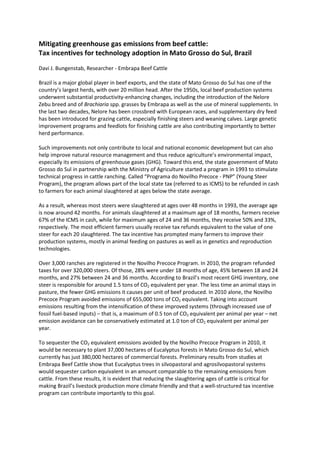
Learning Event No. 3, Session 2: Bungenstab. ARDD2012 Rio.
- 1. Mitigating greenhouse gas emissions from beef cattle: Tax incentives for technology adoption in Mato Grosso do Sul, Brazil Davi J. Bungenstab, Researcher - Embrapa Beef Cattle Brazil is a major global player in beef exports, and the state of Mato Grosso do Sul has one of the country’s largest herds, with over 20 million head. After the 1950s, local beef production systems underwent substantial productivity-enhancing changes, including the introduction of the Nelore Zebu breed and of Brachiaria spp. grasses by Embrapa as well as the use of mineral supplements. In the last two decades, Nelore has been crossbred with European races, and supplementary dry feed has been introduced for grazing cattle, especially finishing steers and weaning calves. Large genetic improvement programs and feedlots for finishing cattle are also contributing importantly to better herd performance. Such improvements not only contribute to local and national economic development but can also help improve natural resource management and thus reduce agriculture’s environmental impact, especially its emissions of greenhouse gases (GHG). Toward this end, the state government of Mato Grosso do Sul in partnership with the Ministry of Agriculture started a program in 1993 to stimulate technical progress in cattle ranching. Called “Programa do Novilho Precoce - PNP” (Young Steer Program), the program allows part of the local state tax (referred to as ICMS) to be refunded in cash to farmers for each animal slaughtered at ages below the state average. As a result, whereas most steers were slaughtered at ages over 48 months in 1993, the average age is now around 42 months. For animals slaughtered at a maximum age of 18 months, farmers receive 67% of the ICMS in cash, while for maximum ages of 24 and 36 months, they receive 50% and 33%, respectively. The most efficient farmers usually receive tax refunds equivalent to the value of one steer for each 20 slaughtered. The tax incentive has prompted many farmers to improve their production systems, mostly in animal feeding on pastures as well as in genetics and reproduction technologies. Over 3,000 ranches are registered in the Novilho Precoce Program. In 2010, the program refunded taxes for over 320,000 steers. Of those, 28% were under 18 months of age, 45% between 18 and 24 months, and 27% between 24 and 36 months. According to Brazil’s most recent GHG inventory, one steer is responsible for around 1.5 tons of CO2 equivalent per year. The less time an animal stays in pasture, the fewer GHG emissions it causes per unit of beef produced. In 2010 alone, the Novilho Precoce Program avoided emissions of 655,000 tons of CO2 equivalent. Taking into account emissions resulting from the intensification of these improved systems (through increased use of fossil fuel-based inputs) – that is, a maximum of 0.5 ton of CO2 equivalent per animal per year – net emission avoidance can be conservatively estimated at 1.0 ton of CO2 equivalent per animal per year. To sequester the CO2 equivalent emissions avoided by the Novilho Precoce Program in 2010, it would be necessary to plant 37,000 hectares of Eucalyptus forests in Mato Grosso do Sul, which currently has just 380,000 hectares of commercial forests. Preliminary results from studies at Embrapa Beef Cattle show that Eucalyptus trees in silvopastoral and agrosilvopastoral systems would sequester carbon equivalent in an amount comparable to the remaining emissions from cattle. From these results, it is evident that reducing the slaughtering ages of cattle is critical for making Brazil’s livestock production more climate friendly and that a well-structured tax incentive program can contribute importantly to this goal.
